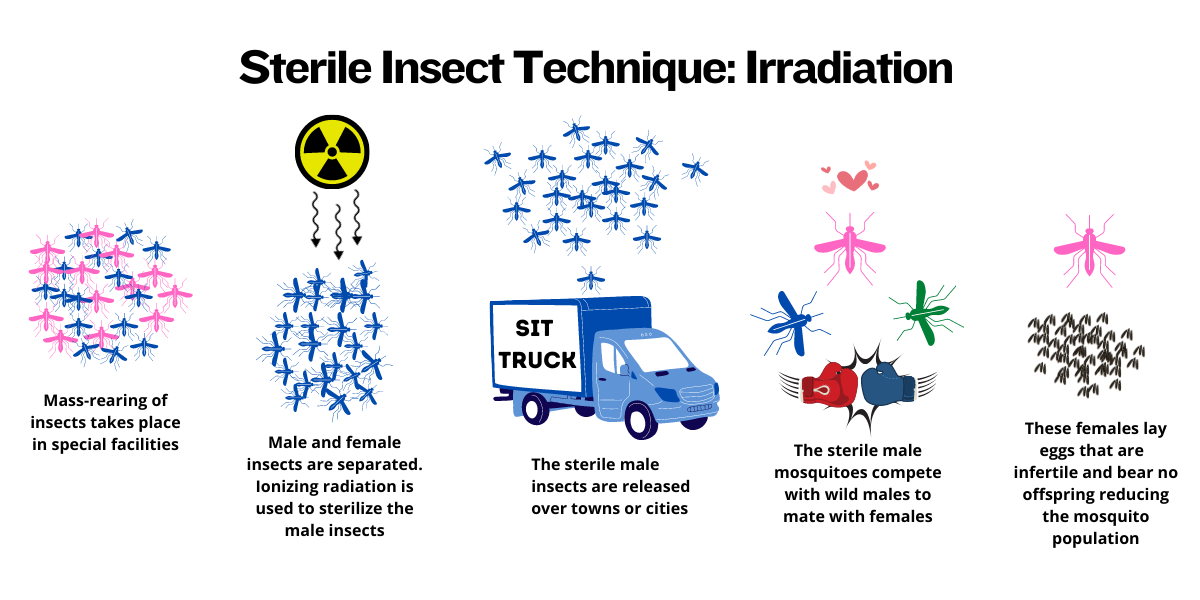Sterile Insect Technique (SIT)

Sterile Insect Technique (SIT)
In efforts to meet public health challenges head-on, the Greater Los Angeles County Vector Control District is looking for innovative and effective technologies to control mosquitoes and combat the spread of mosquito-borne diseases. One of the latest technologies is the Sterile Insect Technique (SIT). SIT is a relatively recent addition to mosquito control and will supplement the traditional mosquito control methods used within the Integrated Vector Management (IVM) program.
What is SIT?
The Sterile Insect Technique (SIT) is an innovative pest control technology used to manage and reduce the populations of certain insect pests that damage crops or transmit diseases. It is an environmentally friendly method that reduces the use of insecticides and maintains the ecosystem. The California Department of Food and Agriculture has successfully used it to control the Mediterranean fruit fly and the United States Department of Agriculture to control the screwworm.
Although the technology has existed since the 1950s, it is a relatively new tool for mosquito and vector control agencies to control the invasive Aedes mosquitoes (commonly referred to as the “ankle-biter”). Aedes mosquitoes are hard to control and can become resistant to commonly used insecticides. As a result, agencies are exploring the use of SIT for mosquito control.
The are three forms of SIT methods- Irradiation, Wolbachia, and Self-limiting gene. The District is exploring the use of irradiation and X-ray sterilization.
Why are we using SIT?
Invasive Aedes mosquitoes have rapidly spread across Los Angeles County since they were detected in 2011. As they expand their presence, the threat of exotic disease outbreaks has increased as well as frequent travel to areas with these disease transmission. In addition, invasive Aedes mosquitoes are difficult to control due to their development of resistance to commonly used insecticides. They lay their eggs in small, hidden water sources in people’s front yards, backyards, patios, and even inside the home — areas where mosquito control agencies can’t easily inspect. Due to the difficult nature of controlling invasive Aedes mosquitoes, many mosquito and vector control agencies have been exploring the use of Sterile Insect Techniques (SIT) and other innovative technologies to help reduce the population of disease-transmitting mosquitoes.
The Greater Los Angeles County Vector Control District is supportive of evaluating the sterile insect technique. Currently, the District is in the research phase and is learning more about the efficacy of these innovative technologies. Federal and state regulatory agencies will determine the safety of innovative approaches in California. SIT would not replace traditional integrated vector management (IVM) or mosquito control tools used to control mosquitoes. It will be another additional tool in the toolbox.
Under the pilot program, the District will release locally reared, non-biting, sterile male mosquitoes (Aedes aegypti) in a specified area within the District’s boundary (using irradiated or x-rayed mosquitoes). This will lower the local population densities of these invasive mosquitoes and reduce the possible threat of tropical diseases like dengue fever and chikungunya.
How does it work?
SIT sterilizes target pests, followed by a systemic, localized, area-wide release of sterile males where they mate with wild females. The released sterile male mosquitoes cannot bite (only the female mosquitoes bite to produce eggs) and cannot spread diseases. Once the sterile males mate with the local females, the resulting eggs are nonviable and will not hatch, therefore reducing the presence of the mosquitoes by lowering the local population densities.
There are three forms of SIT:
- Irradiation
- Wolbachia
- Self-limiting gene
Irradiated mosquitoes are raised in a laboratory where the male mosquitoes are separated from the females. Then, radiation found in X-rays and Gamma rays is used to sterilize male mosquitoes. Females that mate with sterile males lay eggs that do not hatch, which reduces the number of mosquitoes within the specific area.
Process of Irradiation:
- Rearing- large numbers of mosquitoes are raised in a lab.
- Separation - male and female pupae are separated.
- Sterilizing- males are irradiated using ionizing radiation to make them sterile.
- Release- males are then regularly released and compete with wild males to mate with wild females.
- Population Reduction- these females lay eggs that are infertile and bear no offspring reducing the mosquito population.

The EPA evaluated the potential risk of released irradiated mosquitoes into communities and determined there is no risk to people, animals, or the environment.
Wolbachia is a naturally occurring bacteria found in about 60 percent of insects around the world like butterflies, dragonflies, moths, and beetles. With this technique, male Aedes mosquitoes are raised in a lab with a specific type of Wolbachia that they do not normally have. These male Aedes mosquitoes are released to mate with wild female Aedes mosquitoes that have a different type of Wolbachia or none at all. During mating, the mismatched Wolbachia bacteria cause the eggs not to hatch. This can reduce the overall number of Aedes mosquitoes over time.
Self-limiting mosquitoes are produced in a laboratory and carry two types of genes:
- A self-limiting gene that prevents female mosquito larva from surviving to adulthood.
- A fluorescent marker that glows under a special red light. This allows researchers to identify self-limiting mosquitoes in the wild.
Only Aedes male mosquitoes that have a self-limiting gene are released because male mosquitoes don’t bite. When they mate with wild females their offspring inherit a copy of the self-limiting gene. This prevents female offspring from surviving to adulthood, ultimately reducing the number of biting female mosquitoes. These mosquitoes only mate with their own species, and their self-limiting gene can’t be established in the ecosystem.
Sterile Insect Technique_Frequently Asked Questions



